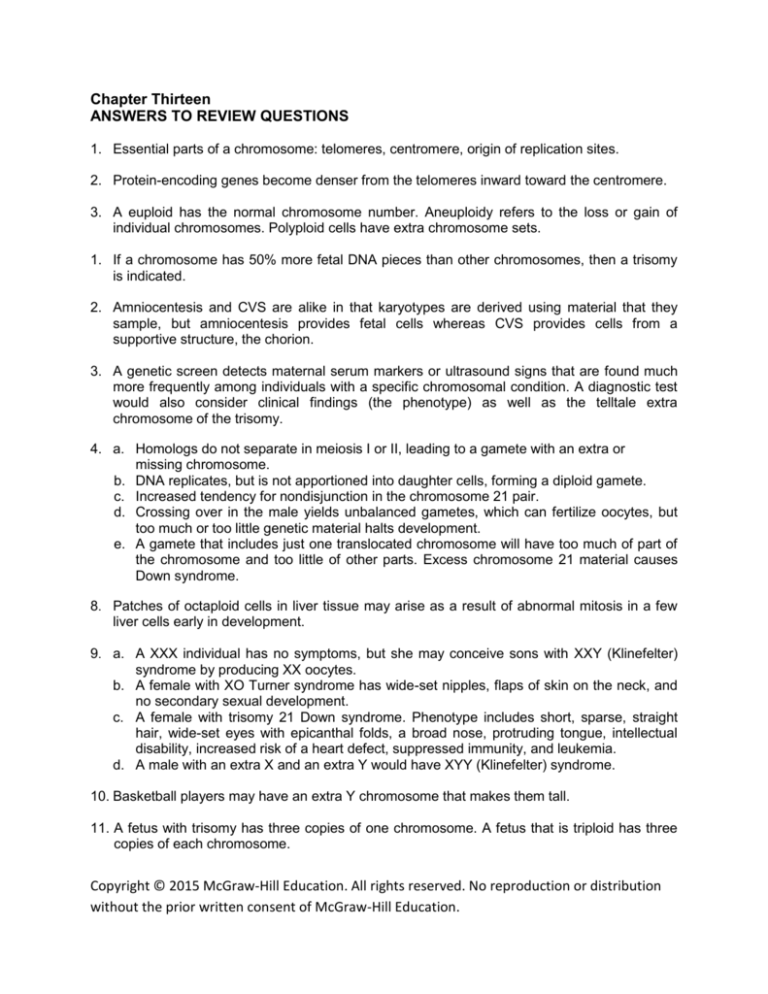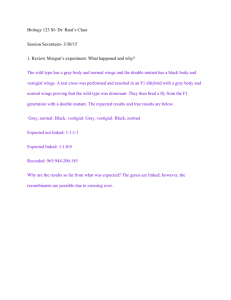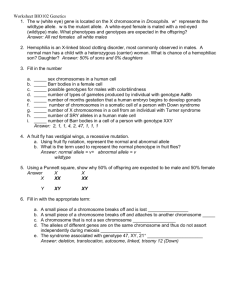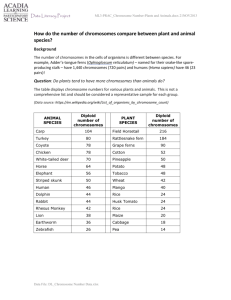
Chapter Thirteen
ANSWERS TO REVIEW QUESTIONS
1. Essential parts of a chromosome: telomeres, centromere, origin of replication sites.
2. Protein-encoding genes become denser from the telomeres inward toward the centromere.
3. A euploid has the normal chromosome number. Aneuploidy refers to the loss or gain of
individual chromosomes. Polyploid cells have extra chromosome sets.
1. If a chromosome has 50% more fetal DNA pieces than other chromosomes, then a trisomy
is indicated.
2. Amniocentesis and CVS are alike in that karyotypes are derived using material that they
sample, but amniocentesis provides fetal cells whereas CVS provides cells from a
supportive structure, the chorion.
3. A genetic screen detects maternal serum markers or ultrasound signs that are found much
more frequently among individuals with a specific chromosomal condition. A diagnostic test
would also consider clinical findings (the phenotype) as well as the telltale extra
chromosome of the trisomy.
4. a. Homologs do not separate in meiosis I or II, leading to a gamete with an extra or
missing chromosome.
b. DNA replicates, but is not apportioned into daughter cells, forming a diploid gamete.
c. Increased tendency for nondisjunction in the chromosome 21 pair.
d. Crossing over in the male yields unbalanced gametes, which can fertilize oocytes, but
too much or too little genetic material halts development.
e. A gamete that includes just one translocated chromosome will have too much of part of
the chromosome and too little of other parts. Excess chromosome 21 material causes
Down syndrome.
8. Patches of octaploid cells in liver tissue may arise as a result of abnormal mitosis in a few
liver cells early in development.
9. a. A XXX individual has no symptoms, but she may conceive sons with XXY (Klinefelter)
syndrome by producing XX oocytes.
b. A female with XO Turner syndrome has wide-set nipples, flaps of skin on the neck, and
no secondary sexual development.
c. A female with trisomy 21 Down syndrome. Phenotype includes short, sparse, straight
hair, wide-set eyes with epicanthal folds, a broad nose, protruding tongue, intellectual
disability, increased risk of a heart defect, suppressed immunity, and leukemia.
d. A male with an extra X and an extra Y would have XYY (Klinefelter) syndrome.
10. Basketball players may have an extra Y chromosome that makes them tall.
11. A fetus with trisomy has three copies of one chromosome. A fetus that is triploid has three
copies of each chromosome.
Copyright © 2015 McGraw-Hill Education. All rights reserved. No reproduction or distribution
without the prior written consent of McGraw-Hill Education.
12. Trisomy is an additional chromosome. Mosaic trisomy is an additional chromosome in some
cell populations. Translocation is movement of a chromosomal segment.
13. Most triploids have severe abnormalities. Trisomy 21 is the least severe trisomy, and
involves the smallest chromosome. XXY syndrome symptoms are worse if there is more
than one extra X chromosome.
14. A balanced translocation causes duplications or deletions when a gamete contains one
translocated chromosome, plus has extra or is missing genes from one of the chromosomes
involved in the translocation. A paracentric or pericentric inversion can cause duplications or
deletions if a crossover occurs between the inverted chromosome and its homolog.
Isochromosomes result from centromere splitting in the wrong plane, duplicating one
chromosome arm but deleting the other.
15. In a Robertsonian translocation, the two long arms of nonhomologous chromosomes fuse,
creating one large translocation chromosome. The short arms are lost. In a reciprocal
translocation, two nonhomologous chromosomes exchange parts. Insertional translocations
insert a sequence from one chromosome into a nonhomologous chromosome.
16. Chromosomes would not contort during meiosis if there is a crossover because their genes
are aligned.
17. a. FISH: Fluorescently-labeled DNA probes bind complementary sequences on
chromosomes.
b. Amniocentesis: Fetal cells and fluid are removed from around a fetus. Cells are cultured
and their chromosomes stained or exposed to DNA probes, and karyotyped.
c. CVS: Chromosomes in chorionic villus cells are directly karyotyped.
d. Cell-free fetal DNA analysis: pieces of fetal DNA are size-separated from the maternal
circulation and pieces corresponding to the chromosomes involved in the most common
aneuploidies compared. If a chromosome is overrepresented, then a trisomy is present.
18. 48
19. A female cannot have XXY syndrome because the presence of the Y chromosome
containing the SRY gene determines sex. A male cannot have Turner syndrome because
there is no Y chromosome to stimulate male development.
20. Nondisjunction in oogenesis, ring chromosome or isochromosome X, or large deletions of
the X chromosome.
21. Isochromosomes have two identical arms with a corresponding duplication and deletion of
genes as compared to normal.
ANSWERS TO APPLIED QUESTIONS
1. a and b. extra chromosome 21 c. hCG and inhibin A are high and UE3, AFP, and PAPP-A
are low. D. 50% more fetal DNA pieces from chromosome 21 than others
Copyright © 2015 McGraw-Hill Education. All rights reserved. No reproduction or distribution
without the prior written consent of McGraw-Hill Education.
2. The person is a girl missing part of the short arm of chromosome 5. This is Cri-du- chat
syndrome, and she will have intellectual disability and a cat-like cry.
3. a. Reciprocal translocation
b. She doesn't have extra or missing genes.
c. She might have a child with translocation Down syndrome.
4. At the second mitotic division, replicated chromosomes failed to separate, yielding one of
four cells with an extra two sets of chromosomes.
5. Down syndrome caused by aneuploidy produces an extra chromosome 21 in each cell. In
mosaic Down syndrome, the extra chromosome is only in some cells. In translocation Down
syndrome, unbalanced gametes lead to an individual with extra chromosome 21 material in
each cell.
6. The XXY son could have gotten two X chromosomes from his mother or an XY-bearing
sperm from his father.
7. a. The translocation carrier can produce an unbalanced gamete that lacks chromosome 22
material.
b. The microdeletion may be more extensive than the deleted region in the translocation
individuals.
c. Translocation family members might be infertile or have offspring with birth defects.
8. Paracentric inversion
9. By changing chromosome number so that only carriers of the translocation are fertile and
can only breed with each other.
ANSWERS TO WEB ACTIVITIES
1. Answers vary with website visited. Problems include getting appropriate care and education,
and physical limitations.
2. student activity
3. Chromosome 13: (1) cataract-clouded lens, OMIM 601885 (2) deafness, OMIM 220290 (3)
leukemia/lymphoma blood cancer, OMIM 602221 (4) ectodermal dysplasia no hair or
nails, dark skin, OMIM 129500
ANSWERS TO CASE STUDIES AND RESEARCH RESULTS
1. a.
b.
c.
d.
Total number of chromosomes and number of copies of chromosome 2.
Nondisjunction.
Chromosome 2 includes many more genes than does chromosome 21.
When the nondisjunction occurred and which cells are affected.
Copyright © 2015 McGraw-Hill Education. All rights reserved. No reproduction or distribution
without the prior written consent of McGraw-Hill Education.
2. One of the Watkins probably has a balanced translocation, because there is more than one
Down syndrome case. The two spontaneous abortions were the result of unbalanced
gametes. Their problems are likely to repeat with a predictable and high frequency, because
the translocated chromosome is in half of the carrier parent's gametes. In contrast, the
Phelps' child with Down syndrome is more likely the result of nondisjunction, which is
unlikely to repeat. The Phelps child has trisomy 21 Down syndrome; the Watkins' child may
only have a partial extra copy of chromosome 21.
3. (a) The long arm. (b) Crossover between the inverted and noninverted homologs.
Deletion.
4. No, they should not be concerned because they are both healthy.
5. Too many cells would have to be manipulated in a person.
Copyright © 2015 McGraw-Hill Education. All rights reserved. No reproduction or distribution
without the prior written consent of McGraw-Hill Education.
(c)









